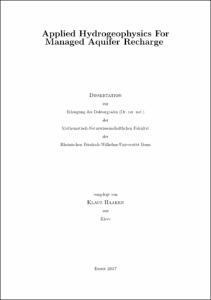Haaken, Klaus: Applied Hydrogeophysics For Managed Aquifer Recharge. - Bonn, 2018. - Dissertation, Rheinische Friedrich-Wilhelms-Universität Bonn.
Online-Ausgabe in bonndoc: https://nbn-resolving.org/urn:nbn:de:hbz:5n-49470
Online-Ausgabe in bonndoc: https://nbn-resolving.org/urn:nbn:de:hbz:5n-49470
@phdthesis{handle:20.500.11811/7482,
urn: https://nbn-resolving.org/urn:nbn:de:hbz:5n-49470,
author = {{Klaus Haaken}},
title = {Applied Hydrogeophysics For Managed Aquifer Recharge},
school = {Rheinische Friedrich-Wilhelms-Universität Bonn},
year = 2018,
month = feb,
note = {This thesis investigates the application of hydrogeophysical monitoring and characterization techniques in the context of managed aquifer recharge (MAR). MAR is a sustainable technology in modern water resources management. It denotes the storage, purification, and reclamation of water in aquifers under controlled conditions. MAR receives increasing attention due to generally increasing water demand, especially in (semi-)arid areas. Successful implementation and operation of MAR requires a detailed knowledge of the system in terms of geology and hydrogeology. Therefor, spatially extensive, high-resolution non-invasive geophysical techniques in combination with classical hydro-geological approaches can provide key information. In this thesis, both field monitoring and numerical modeling of different concepts of MAR using hydrogeophysics are presented. A focus lies on the geoelectrical imaging method which can monitor the movement of water in the subsurface with high spatial and temporal resolution due to the direct relation of electrical conductivity to water salinity and/or water saturation. The geoelectrical method is applied to i) simple surface infiltration schemes in order to quantify the volume of infiltrated water, ii) soil aquifer treatment to monitor cyclic ponded infiltration under high fluxes, and iii) aquifer storage and recovery, aiming at understanding complex saline-freshwater systems. The thesis shows that by means of petrophysical models, a quantification of water volume can be achieved using time-lapse electrical imaging. Furthermore, a new approach of temporal-based aquifer zonation is presented by using time-lapse electrical imaging under very high water fluxes. It shows that the heterogeneous subsurface can be imaged for hydraulic characteristics which is not possible with classical approaches or with a single electrical measurement alone. In another study, the complex saline-freshwater interactions of freshwater injection in a hyper-saline aquifer is investigated in a field monitoring and numerical modeling study. The simulation results were used to be compared against the real field results. The exercise demonstrates that the evolution of the freshwater is strongly influenced by the system's hydraulic heterogeneities. This thesis highlights how the joint use of geophysics with hydro-geological approaches as well as numerical modeling give fundamental information for MAR applications. Eventually, the presented approaches of hydrogeophysics can be used to enhance the implementation and operation of MAR applications.},
url = {https://hdl.handle.net/20.500.11811/7482}
}
urn: https://nbn-resolving.org/urn:nbn:de:hbz:5n-49470,
author = {{Klaus Haaken}},
title = {Applied Hydrogeophysics For Managed Aquifer Recharge},
school = {Rheinische Friedrich-Wilhelms-Universität Bonn},
year = 2018,
month = feb,
note = {This thesis investigates the application of hydrogeophysical monitoring and characterization techniques in the context of managed aquifer recharge (MAR). MAR is a sustainable technology in modern water resources management. It denotes the storage, purification, and reclamation of water in aquifers under controlled conditions. MAR receives increasing attention due to generally increasing water demand, especially in (semi-)arid areas. Successful implementation and operation of MAR requires a detailed knowledge of the system in terms of geology and hydrogeology. Therefor, spatially extensive, high-resolution non-invasive geophysical techniques in combination with classical hydro-geological approaches can provide key information. In this thesis, both field monitoring and numerical modeling of different concepts of MAR using hydrogeophysics are presented. A focus lies on the geoelectrical imaging method which can monitor the movement of water in the subsurface with high spatial and temporal resolution due to the direct relation of electrical conductivity to water salinity and/or water saturation. The geoelectrical method is applied to i) simple surface infiltration schemes in order to quantify the volume of infiltrated water, ii) soil aquifer treatment to monitor cyclic ponded infiltration under high fluxes, and iii) aquifer storage and recovery, aiming at understanding complex saline-freshwater systems. The thesis shows that by means of petrophysical models, a quantification of water volume can be achieved using time-lapse electrical imaging. Furthermore, a new approach of temporal-based aquifer zonation is presented by using time-lapse electrical imaging under very high water fluxes. It shows that the heterogeneous subsurface can be imaged for hydraulic characteristics which is not possible with classical approaches or with a single electrical measurement alone. In another study, the complex saline-freshwater interactions of freshwater injection in a hyper-saline aquifer is investigated in a field monitoring and numerical modeling study. The simulation results were used to be compared against the real field results. The exercise demonstrates that the evolution of the freshwater is strongly influenced by the system's hydraulic heterogeneities. This thesis highlights how the joint use of geophysics with hydro-geological approaches as well as numerical modeling give fundamental information for MAR applications. Eventually, the presented approaches of hydrogeophysics can be used to enhance the implementation and operation of MAR applications.},
url = {https://hdl.handle.net/20.500.11811/7482}
}






